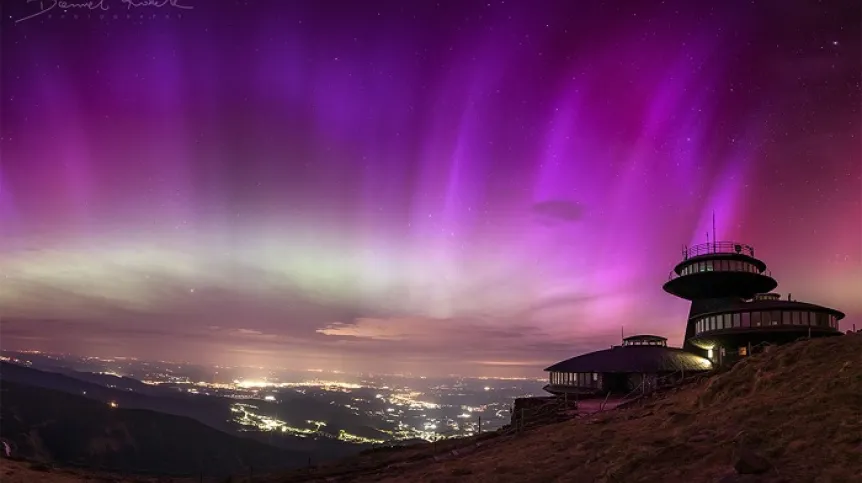
The photo of the aurora borealis over Śnieżka, taken by Daniel Koszela, was selected NASA's Astronomy Picture of the Day on June 12. The photograph was taken spontaneously and with great luck, Koszela told PAP.
The photograph of the aurora borealis over the highest peak of the Karkonosze Mountains - Śnieżka (1,603 m above sea level) was taken on May 11 this year, during the strongest geomagnetic storm in years.
'It was almost as strong as the famous Carrington storm of 1856! This is a historic photo of the northern lights in the Karkonosze Mountains - the first one that is so beautiful and spectacular - since the beginning of photography’, Koszela said.
He added: ‘Science populariser Karol Wójcicki posted in the evening on his profiles that a very strong, historic geomagnetic storm was coming and the aurora borealis would be visible in Poland. He added that this was +not a drill+, we should grab the equipment and go +hunting+. There were heavy clouds over the Jelenia Góra Valley and the conditions for observing the sky were poor. However, above the Karkonosze Mountains it was noticeable that the clouds could not break through the mountain barrier and behind them, there was a clear sky over Czechia. I decided it was worth a try.’
The climb to Śnieżka took him about 2 hours - a backpack with photographic equipment weighs on average 12-15 kg. 'Already on Równia pod Śnieżką, at the Dom Śląski shelter, you could see the stars above the zenith, although the clouds were still over the Polish part. I started taking photos of the shelter and saw a pink glow in the photos at the zenith above the shelter. Overjoyed, I headed towards Śnieżka - my goal. For several months I had dreamed of photographing the peak and the meteorological observatory (which looks unreal) against the background of the aurora borealis. I knew it was possible because on November 6, 2023, the aurora was visible from the Jelenia Góra Valley (the storm's strength reached KP6)', Koszela said.
'Pillars of light appeared - a historic phenomenon at this latitude,’ he continued. ‘It lasted maybe 10 minutes. It was enough to take several panoramic shots. I was in the perfect place and time! The glow of the aurora itself, in colours from purple to green, was visible all night long, until the so-called morning aurora. It was also visible on the southern side of the sky, which was unusual. Ever since I have been interested in photography, I have not heard of the aurora being so visible in the Karkonosze Mountains. There were several photos taken in the past with glows and delicate pillars of light on the northern horizon The aurora that took place on May 10-11 will go down in the history of astronomy.’
Koszela has been a professional photographer for 12 years. He started with landscape photography. His photographic specialties include: reportage, landscape, drone photography and astrophotography. He won many photography competitions in Poland and abroad, including 1st place - for the photo 'Falling Skiers' - in the SPORT category in the prestigious Siena Drone Awards 2022 photo competition, as well as 3rd place for the photo of Śnieżka with the Moon, titled 'Moon Base', in the 'Our Moon' category in the Insight Investment competition Astronomy Photographer of the Year 2020.
Astronomy Picture of the Day (APOD) website has been run by NASA since 1995. One photo of astronomical objects or astrolandscape is published every day. In recent months, this distinction was awarded to several authors from Poland: Marcin Rosadziński, Mariusz Durlej, Antoni Zegarski and Marcin Ślipko. (PAP)
bar/ wus/ kap/
tr. RL













